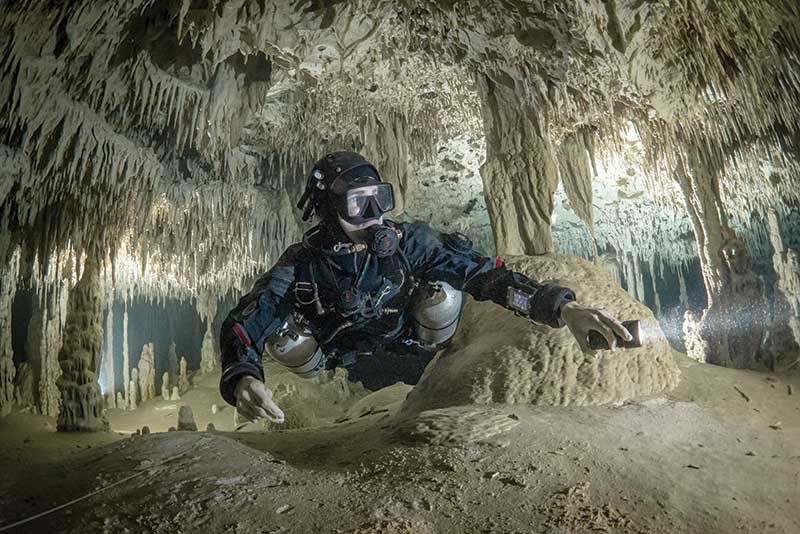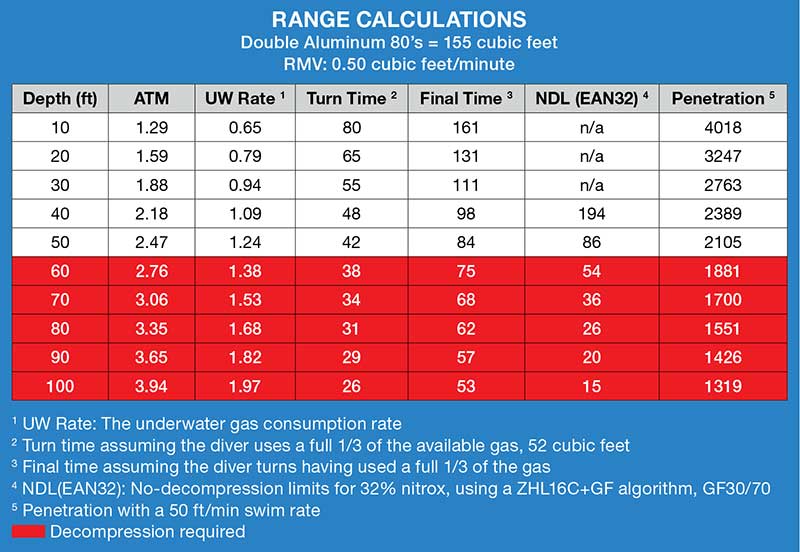How I Plan My Cave Dives
By Natalie Gibb

Where I live in Mexico, the caves are shallow, delicately decorated, and welcoming. The caves are so shallow, in fact, that most of the time decompression status is not an issue. The water is so clear and warm that divers can swim for hours following the line in a comfortable, easy environment. Yet these same conditions lead to sloppy dive habits. I find many divers fall into complacent behaviour, and just swim along the guideline until they hit thirds, without a proper plan. What do I consider a proper plan?
Most of my cave dive planning revolves around two basic tools: (1) my average gas consumption rate, calculated over my dive career, and (2) a map of the dive site (either a wall map, or a survey). With these tools, I can plan my expected dive time, decompression obligation, and penetration distance, as well as anticipate what cave features or tunnels I expect to see during the dive. As I dive, I look for these navigational cues and confirm my location based on my plan. It’s much more satisfying then just following a line.
If you are interested in learning my style of dive planning, the first thing you need to know is your surface gas consumption rate (the term respiratory minute volume (RMV) can be used interchangeably for the purposes of this discussion). A diver’s surface gas consumption rate can be calculated in simulated conditions, such as in a pool, but I find it much more useful and realistic to calculate mine after each cave dive. I record the information, and over a series of dives I get a feel for the range my rate usually falls into. It becomes really interesting to do this in different conditions, such as in cold water, high flow, etc.
Surface gas consumption rates are given in ft3/min at 1 atm of pressure, or in litres/min at 1 atm of pressure. There are formulas for this, which is beyond the scope of this column, or you can simply go online and find a surface gas consumption rate calculator such as www.divebuddy.com/calculator/sac. If you use this calculator in metric, you will additionally need to look up your tank capacity in litres, which is also just a quick google.
- For double tanks, be sure that you use twice the volume of a single tank in the “tank volume” input field—for example, if you dive double Al80’s (the volume of a single aluminum 80 is 77.5 ft3) use 155 ft3 in the tank volume field.
- If you’re in sidemount, use the average start and ending pressures of your two tanks to calculate your gas usage in psi or bar.
Let’s say I use the calculator for a dive on in sidemounted double aluminum 80’s, starting with 3000 psi in each tank and finishing with 1600 psi, at and average depth of 30 feet, for 75 minutes. I would have a surface gas consumption rate (RMV) of about 0.50 ft3 per a minute. Now what do I do with that information from a planning standpoint?

Do the calculations
How long will the dive be? Using my surface gas consumption rate, I can anticipate about how long I can stay underwater at a given depth on a cave dive. There’s a few steps to this:
Convert the planned average depth of your dive to atm (atmospheres), for freshwater:
Imperial: Average Depth (ft) ÷ 34 + 1
Metric: Average Depth (m) ÷ 10 + 1
If my planned dive is 80 feet average depth, I would be at 3.35 atm.
Multiple my surface gas consumption rate by the average depth in atm, this gives me my underwater gas consumption rate, in this case 0.5 ft3 /min x 3.35 atm = approximately 1.68 ft3/min.
Divide the available gas for the dive by my breathing rate underwater. For double aluminum 80’s, I would have 155 cubic feet total gas, which according to the rule of 1/3rds dives me 52 cubic feet of gas for penetration. So 52 ft3 ÷ 1.68 ft3 /min = 31 minutes of penetration, 31 minutes of exit, and a total dive time of 62 minutes.
With a basic estimate of the turn time and total time, I can confirm that I have ample burn time on my lights for the dive. I can consider whether my thermal protection will be enough for entire dive. If it’s not, I will simply plan to turn on time, instead of using all of my available gas! Finally, in the unlikely event that the pressure gauge becomes inaccurate (once, I had a needle stick at 2400 psi) I still have a turn time that will have me exiting with about the correct amount of gas, regardless of whether the gauge is accurate.
Other considerations
Should I be concerned about deco? Some cave dives require decompression, and some do not. One danger of the typically shallow dives where I live is that divers tend not to pay attention to no-decompression limits, and sometimes run into unplanned decompression obligations if they dive straight to thirds.
For the deco algorithm I prefer, (you can look up your computer’s algorithm, use the planning mode on your computer, or even better, use tables) the NDL for 80 ft on 32% nitrox would be 26 minutes, but my max dive time according to gas availability is 62 minutes! This means that I would either need to plan for deco or adjust my dive time to avoid deco entirely. It would be dangerous to just go on this dive following the rule of 1/3s without any consideration for deco. Sadly, many people where I dive do just that.
How far can I go? This requires an idea of your swim rate. Most divers in low-flow conditions swim about 50 ft (15 m)/ min. This means that on this dive, if I used a full third of my gas, I could dive: 50 ft/min x 31 minutes = 1550 ft into the cave!
Where can I get to on the map? The penetration range becomes really interesting for dive planning. Looking at a cave map, a diver can see what tunnels lie within his or her range. Can you make it to the Blue Abyss, or do you need a stage? Is the circuit you are planning within your range, or will you only barely make it? This sort of planning removes any guess work from dives with end-goals, and allows the divers to swim at their normal rate without stress, confident that a certain tunnel or attraction is well within their abilities.
What navigation cues can I look for during my dive? When will I reach a T-intersection or a jump? Knowing your swim rate and using a map with a scale, you can estimate approximately when you will see navigational cues such as a T-intersection or a jump. This can help you to make a solid plan, as well as to understand where you are during the dive. Is there is a T-intersection 300 ft into the dive? You should see it in about 6 minutes. When that happens like clockwork, it feels pretty amazing!
I have my students make a chart for the type of tanks they use, assuming they will use a full 1/3 of gas for penetration (we usually still turn early). Using this chart, we can examine the maximum dive times, swimming ranges, and decompression obligations at each possible depth. The chart makes allows us to create detailed dive plans efficiently, and students start to memorize their max times and ranges at each depth as they work with the data. Of course, no dive will go absolutely according to plan, but it’s surprising how accurate this type of approximated plan can be!
Natalie Gibb is a full cave instructor, explorer, and researcher based in Mexico’s Riviera Maya. She is a published author, international speaker, and cave conservationist. For more visit: www.underthejungle.com
Leave a Comment







